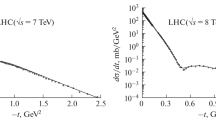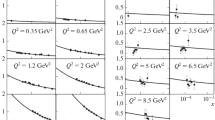Summary
It is shown that in the framework of the coherent droplet model the differential cross-section of the elastic scattering of two hadrons is not necessarily proportional to the square of the product of the hadronic matter form factors whenq → ∞,q being the momentum transfer. Examples are given to prove—contrary to assumptions made in the literature—that the rapid decrease of the spectral weight function, whenq → ∞, does not secure the above relationship between cross-section and form factors. It is the effective interaction which determines uniquely the behaviour of the cross-section as a function of momentum transfer and strength of interaction: i) Interactions with a cusplike or logarithmic singularity at the origin give rise to differential cross-sections which are proportional to the square of the strength of the interaction as well as to the product of the form factors. In this case the cross-section behaves like some power of 1/q, whenq → ∞. ii) Interactions which are smooth at the origin, in other words expandable in ascending powers ofr 2 about the origin, give rise to cross-sections which are not related in any simple way to the square of the product of the form factors. In this case the cross-section decreases faster than any power ofq. In both i) and ii) it is possible to construct rapidly decreasing, as well as nondecreasing, spectral weight functions, whenq → ∞.
Riassunto
Si mostra che nell’ambito del modello coerente a gocce la sezione d’urto differenziale dello scattering elastico di due adroni non è necessariamente proporzionale al quadrato del prodotto dei fattori di forma della materia adronica quandoq → ∞. Essendoq il trasferimento d’impulso. Si portano degli esempi per dimostrare, contrariamente alle ipotesi della letteratura corrente, che la diminuzione rapida della funzione spettrale del peso, quandoq → ∞, non assicura l’intercorrere della precedente relazione fra sezione d’urto e fattori di forma. Èl’interazione efficace che determina unicamente l’andamento della sezione d’urto in funzione del trasferimento d’impulso e della forza di interazione: i) Interazioni con singolarità a cuspide o logaritmica all’origine danno luogo a sezioni d’urto differenziali che sono proporzionali al quadrato della forza d’interazione cosi come al prodotto dei fattori di forma. In questo caso la sezione d’urto si comporta come una potenza di 1/q, quandoq → ∞. ii) Interazioni regolari all’origine, in altre parole sviluppabili in potenze crescenti dir 2 attorno all’origine, danno luogo a sezioni d’urto che non sono correlate in alcuna maniera semplice al quadrato del prodotto dei fattori di forma. In questo caso la sezione d’urto diminuisce più rapidamente di qualsiasi potenza diq. In entrambi i casi i) e ii) è possibile costruire funzioni spettrali del peso rapidamente decrescenti, ed anche non decrescenti, quandoq → ∞.
Реэюме
Покаэывается, что в рамках когерентной капельной модели дифференциальное поперечное сечение упругого рассеяния двух адронов не является обяэательно пропорциональным квадрату проиэведения форм-факторов адронного вешества приq → ∞, где q есть передаваемый импульс. Приводятся примеры, чтобы докаэать, в противоположность предположениям, испольэованным в литературе, что быстрое убывание спектральной весовой функции приq → ∞ не обеспечивает выщеупомянутое соотнощение между поперечным сечением и форм-факторами. Эффективное вэаимодействие, которое одноэначно определяет поведение поперечного сечения, как функцию передаваемого импульса и силы вэаимодействия представляет: i) Вэаимодействия с синтулярностями типа точки воэврата или логарифмической сингулярностью в начале дают дифференциальные поперечные сечения, которые пропорциональны квадрату силы вэаимодействия, а также проиэведению формфакторов. В зтом случае поперечное сечение ведет себя, как некоторая степень 1/q приq → ∞. ii) Вэаимодействия, которые являются плавными в начале координат, другими словами, которые раэлагаются в ряд по воэрастаюшим степеням г2 вблиэи начала отсчета, приводят к поперечным сечениям, которые не свяэаны простым обраэом с проиэведением форм-факторов. В зтом случае поперечное сечение уменьщается быстрее, чем любая степеньq. В обоих случаях Г) и и) можно сконструировать быстро убываюшую, а также неубываюшую спектральные весовые функции приq → ∞.
Similar content being viewed by others
References
T. T. Wu andC. N. Yang:Phys. Rev.,137, B 708 (1965).
N. Byers andC. N. Yang:Phys. Rev.,142, 976 (1966).
T. T. Chou andC. N. Yang:Proceedings of the Second International Conference on High-Energy Physics and Nuclear Structure (Amsterdam, 1967).
L. Durand III andR. Lipes:Phys. Rev. Lett.,20, 637 (1968).
R. J. Glauber:Lectures in Theoretical Physics, Vol.1 (Boulder, Colo., 1958).
G. Molière:Zeits. Naturf., A2, 133 (1947).
See,e.g.,A. Erdélyi:Asymptotic Expansions (New York, N. Y., 1956).
A. Paliov (Lev) andS. Rosendorff:Ann. of Phys.,66, 189 (1971).
A. Paliov (Lev) andS. Rosendorff:Journ. Math. Phys. (to appear only February 1975 owing to lack of funds for publication charges).
S. Rosendorff andS. Tani:Phys. Rev.,128, 457 (1962).
R. Serber:Phys. Rev. Lett.,10, 357 (1963).
See,e.g.,E. C. Titchmarsh:Introduction to the Theory of Fourier Integrals, Second Edition (Oxford, 1948), p. 317.
See,e.g., Handbook of Mathematical Functions, edited byM. Abramowitz andI. A. Segun (New York, N. Y., 1968), p. 232.
See,e.g., Handbook of Mathematical Functions, edited byM. Abramowitz andI. A. Segun (New York, N. Y., 1968), p. 300.
S. D. Drell, A. C. Finn andM. H. Goldhaber:Phys. Rev.,157, 1402 (1967).
Tables of Integral Transforms, Vol.2, edited byA. Erdélyi (New York, N. Y., 1954), p. 30;Higher Transcendental Functions, Vol.2, edited byA. Erdélyi (New York, N. Y., 1953), p. 119.
See,e.g.,W. Magnus andF. Oberhettinger:Formulas and Theorems for the Functions of Mathematical Physics (New York, N. Y., 1949).
See,e.g.,H. B. Dwight:Tables of Integrals and Other Mathematical Data, Fourth Edition (New York, N. Y., 1969), p. 148.
Author information
Authors and Affiliations
Rights and permissions
About this article
Cite this article
Rosendorff, S. Some considerations concerning the coherent droplet model of high-energy hadron-hadron scattering. Nuov Cim A 20, 613–646 (1974). https://doi.org/10.1007/BF02727456
Received:
Published:
Issue Date:
DOI: https://doi.org/10.1007/BF02727456




